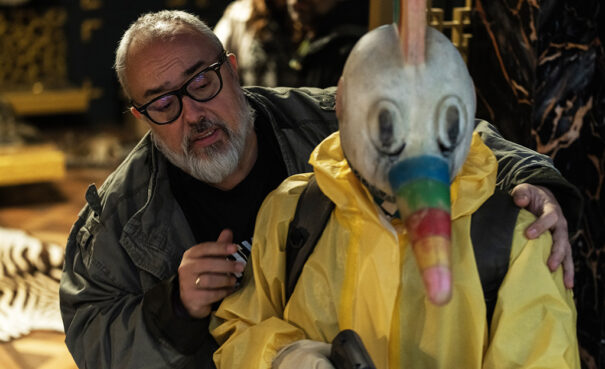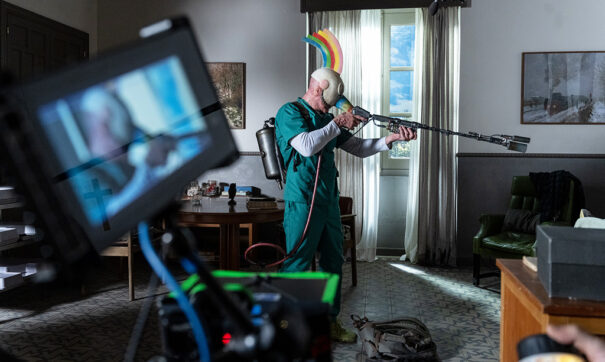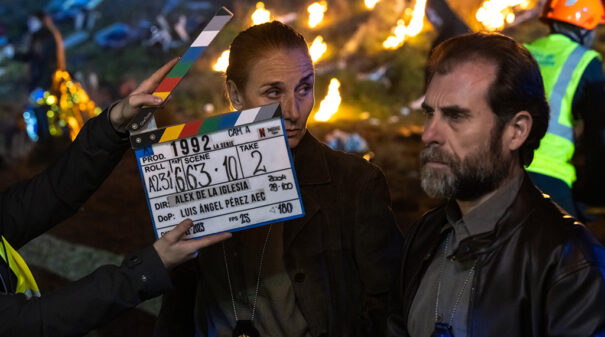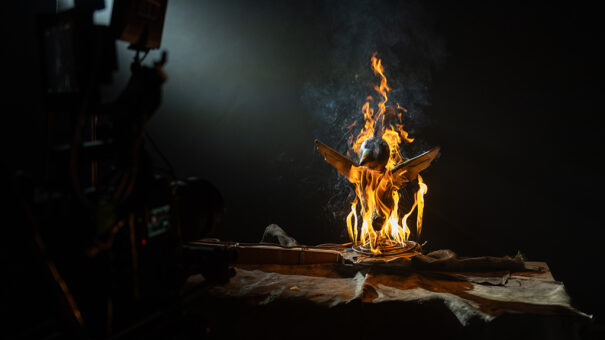'1992': Sevilla, a macabre job and DaVinci Resolve, in the latest series by Álex de la Iglesia
DaVinci Resolve (Blackmagic Design) fue el software empleado para dar forma al color de ‘1992’, serie de Netflix dirigida por Álex de la Iglesia que lleva el thriller más impactante a la Sevilla noventera con un oscuro Curro como antagonista.
Los fans del clásico de culto Seven habrán notado un paisaje visual familiar en la reciente serie de Netflix 1992. Creada y dirigida por el reconocido cineasta español Álex de la Iglesia, la serie traslada al espectador a una oscura y siniestra reinterpretación de la Sevilla de los años 90, donde una viuda (Marian) investiga una serie de asesinatos vinculados a la Expo 92 tras la muerte de su marido en una explosión.
Las explosiones y el uso del fuego forman parte esencial de la narrativa visual de la serie (un lanzallamas aparece en varias secuencias clave como arma principal del asesino), en un intento por retratar una Sevilla nostálgica pero fantasmal (con localizaciones como la Isla de la Cartuja en estado de abandono), fusionando la energía vibrante de los 90 con una atmósfera decadente.
El thriller oscuro de David Fincher, Seven, se citó desde las primeras reuniones de producción como referencia visual, mientras De la Iglesia, conocido por su estilo narrativo caótico y barroco, delineaba su visión junto al director de fotografía Luis Ángel Pérez: “Conocía al productor y a Álex por una película llamada La Piedad, en la que fui director de fotografía. Tiene una visión muy específica, loca pero brillante del cine, con un enfoque narrativo muy caótico”, explica Pérez sobre lo que lo atrajo al proyecto. “Cuando me confirmaron, empezamos a hablar de referencias y, sobre todo, hubo una premisa clara por su parte: utilizar Seven como guía para la paleta de color y los niveles de oscuridad; cosas como los contrastes radicales entre luz y sombra”, añade.
Esos contrastes radicales también se trasladaron al uso insistente de lluvia artificial, independientemente de las condiciones reales de rodaje: “No le importaba que estuviéramos rodando al aire libre bajo pleno sol; su intención estética y narrativa iba mucho más allá de buscar realismo”, detalla. La intención era exagerar esas condiciones mediante técnicas de iluminación, marcando así una clara ruptura con la realidad en favor de la intención narrativa: “El cine de Álex es lo opuesto a lo sutil. Le gusta enfatizar, que haya evidencia de la interpretación de los actores, de la puesta en escena, etc. Y todo eso impacta directamente en la cámara, la luz y la corrección de color”.
La corrección de color en un thriller
Para dar vida a este thriller gótico, se requirió una estrecha colaboración entre Pérez, el colorista Jordi Molina y el resto del equipo de producción. Esto fue clave para mantener la atmósfera del thriller a lo largo de una producción que combinaba localizaciones reales y rodajes en estudio.
Para lograrlo, el equipo de Molina trabajó en espacio de color ACES, con montaje online, etalonaje y efectos visuales integrados en DaVinci Resolve. “La primera ventaja de trabajar en ACES es que podíamos avanzar en la corrección sin esperar a que los efectos estuvieran terminados; sabíamos que los planos se comportarían como si fueran el material original de cámara”, explica Molina, quien añade que “la segunda ventaja es que podíamos preparar los plates para los VFX. Al transcodificar a EXR y usar ACES, sabíamos que verían exactamente lo mismo que nosotros en la sala de color”. DaVinci Resolve sirvió como lenguaje común entre todos los departamentos: “Para nosotros, DaVinci fue como un diccionario que conectó todos los programas dentro de una misma pipeline de color, algo de lo que nos beneficiamos enormemente en este proyecto”.
La estética visual fue anticipada por Arturo García (Biaffra) y Luis Arrizabalaga, colaboradores habituales de De la Iglesia, quienes localizaron las ubicaciones con referencias fotográficas específicas para composición, luz y color. Dado que se rodó entre Sevilla (exteriores) y Madrid (interiores), Pérez explica que desde scouting ya se intuía la importancia de una iluminación de bajo perfil: “Teníamos que evitar colores muy brillantes o chillones: rojos, azules, verdes. La paleta era mucho más apagada, con una saturación baja. Predominaban los negros, mostazas, ocres y amarillos muy lavados”, comenta Molina. En ese contexto atenuado, los contrastes se vuelven aún más significativos. Por ejemplo, el blanco se asocia al personaje de Marian, que aparece en muchas secuencias con una chaqueta blanca, lo que la destaca del entorno sombrío que la rodea.
Las localizaciones presentaron uno de los principales retos, ya que la luz natural del verano sevillano era extremadamente intensa para las tomas exteriores, en contraste con la atmósfera oscura y más contenida de las escenas interiores rodadas en Madrid. Con las fechas de rodaje previstas con antelación, Pérez y su equipo pudieron anticipar los retos y convertirlos en oportunidades narrativas. “Sabíamos que trabajaríamos con mucha luz natural en exteriores. Aunque había partes en estudio, la mayoría era en localización, así que tuvimos que pensar cómo esa luz bestial de Sevilla en julio o agosto nos afectaría frente a interiores mucho más oscuros y lúgubres. En vez de verla como un enemigo, decidimos aliarnos con esa luz y aprovecharla para reforzar el relato.”
En estrecha colaboración con Pérez, el colorista Jordi Molina detalla los retos de esas condiciones extremas: “Con temperaturas superiores a los 40 °C, controlar la luz y la saturación del color añadía una capa más de complejidad”, comenta. A pesar de ello, lograron “crear secuencias en las que la interacción entre fuego, sombras y entorno resulta visceral e inmersiva”.
Una colaboración dinámica
Molina ya había trabajado con De la Iglesia en producciones como 30 Monedas, por lo que tenía muy claras sus preferencias y expectativas para 1992. Junto con Pérez, se centraron en equilibrar imágenes de alto contraste preservando detalle tanto en sombras como en altas luces, algo que exigió muchas pruebas en preproducción, especialmente al tratarse de una serie masterizada en HDR.
“Como Jordi ya conocía los gustos y lo que Álex iba a pedir, me reuní con él y con el DIT Miguel Meiser varias veces en preproducción después de leer los guiones. Como iba a terminar en un máster HDR, necesitábamos anticipar los problemas que podíamos tener con la luz natural de Sevilla y con las grandes fuentes de luz que requerían los interiores”, explica Pérez, a lo que Molina añade: “La serie aprovecha al máximo el amplio rango dinámico del HDR. (…) Las sombras juegan un papel crucial para amplificar el misterio, con negros profundos que mantienen textura sin perder detalle. DaVinci ofrece herramientas excelentes como Color Warper y Shadows para recuperar texturas en zonas oscuras, y su legendario sistema de tracking hizo muy sencillo empatar planos”.
El HDR fue clave para lograr el estilo contrastado y lleno de negros profundos que De la Iglesia buscaba, pero también presentó desafíos. Pérez y Molina desarrollaron LUTs específicas para interiores y exteriores, asegurando que los detalles sutiles en las sombras y los contrastes extremos se mantuvieran visibles. Esto exigió un equilibrio preciso entre iluminación en set y corrección en postproducción.
Pérez menciona una técnica que Molina llama “desenterrar la imagen”, donde los niveles de brillo y contraste se descomponen y reconstruyen para obtener imágenes exageradas: rostros, texturas, fondos… No son realistas, “pero son coherentes con el universo que quiere contar Álex. Tiene una estética muy particular y la verdad es que por eso se reconocen sus películas al instante.”
Explosiones que cobran vida
Algunas de las secuencias más importantes giran en torno al fuego, combinando efectos prácticos con recreaciones 3D dinámicas.b“Capturar la interacción entre fuego y entorno supuso un gran reto para el equipo de fotografía, que trabajó estrechamente con el DIT”, explica Molina. Conservar el detalle en las altas luces y las sombras era fundamental para que el movimiento de la llama y las texturas circundantes se representaran fielmente.
“En las localizaciones donde no se podía usar fuego real por seguridad, mezclamos efectos prácticos con recreaciones 3D en DaVinci, integrándolos para mantener la autenticidad visual de cada plano”, un proceso que Molina señala como el más complejo del proyecto. “El fuego generado por ordenador tenía que coincidir exactamente con los niveles de brillo del fuego real”, asegura, para lograr continuidad entre escenas interiores y exteriores. “Hay mucho fuego: el lanzallamas, las explosiones… Y tuvimos que ser muy cuidadosos con esos detalles; animarlos mucho y protegerlos porque sabíamos que eran clave para la narrativa y porque queríamos que técnicamente fueran lo más perfectos posible”, añade Pérez.
El fuego se presenta como un elemento clave desde el primer momento, y Pérez destaca especialmente la secuencia inicial como una de sus favoritas. “Estoy muy contento con la secuencia de apertura, cuando Marian entra tras la explosión. Creo que quedó muy bien: luz baja en interiores con destellos del humo exterior, filtrado por la lluvia artificial…” Una escena que, según él, encapsula perfectamente la atmósfera de thriller oscuro que define la serie, pero bajo la lente amplia del caos no-realista de De la Iglesia: “No hay ningún momento en el que sientas que estás viendo la realidad. A veces el cine transforma la realidad en algo súper exagerado, y al final ese es el juego para los que trabajamos en la imagen”.
https://youtu.be/GZKbtONOI64
Did you like this article?
Subscribe to our NEWSLETTER and you won't miss anything.






